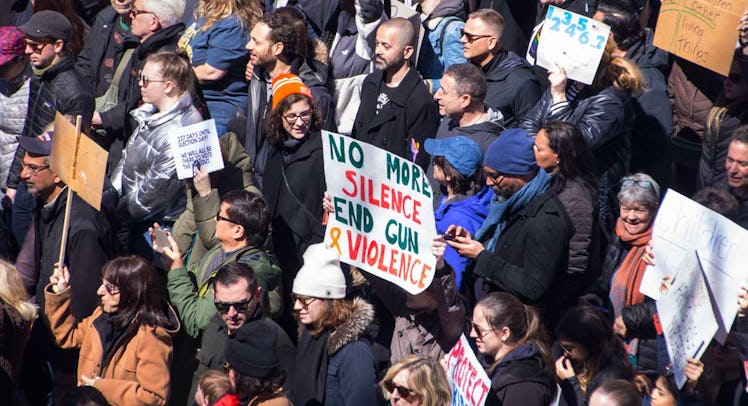At The March for Our Lives, Teachers and Parents Follow Teens for a Change
The March For Our Lives in New York City attracted thousands of adults ready to let kids lead.

Stroller-pushing thirtysomethings, sign-waving octagenarians, and chanting teens, a sea of them, crammed into a roughly 40-block area to participate in the New York March for Our Lives. Of the 150,000 participant-protesters, a disproportionate number were parents and teachers determined to protect kids both in that moment — a father chased a pair of scootering grade schoolers — and into adulthood. Asked about why they came, parents and kids cited figures, their fears, the seventeen who died in Parkland, and the fact that adults are listening. They spoke about a desire to move past an unacceptable status quo.
“I’m here because we practice protecting kids from guns,” said one teacher. “I have to think about which closets to put them in. Then I have to think about what to do with myself when I lock the door.”
Many teachers and students had fashioned signs out of tri-fold cardboard, the unofficial paperstock of science fairs everywhere. Others had taped posters to wooden rulers. To an extent, the protest looked like an after-school activity. And, to an extent, it was one.
Victoria Fasold for Fatherly
The March for Our Lives was organized in response to the shooting at Marjory Stoneman Douglas High in Parkland, Florida, where Nikolas Cruz, armed with an AR-15, murdered 15 students and two educators in six minutes. In the wake of that tragedy, Marjory Stoneman Douglas chose activism over victimhood, demanding legislative changes and shouting down politicians intent on offering thoughts prayers and little else. On the Sunday of the march, those students were speaking in Washington D.C., but the power of their words was perhaps best understood from a remove. People in New York hadn’t come to see something. There were few speeches or performances.
They had come to say something. Or, in the case of many parents, to support children trying to say something.
“I’m here to support my daughter,” proudly explained Junior Seville, a local father who deferred to his teenage daughter on the politics. “I’m happy that it’s mostly teens who organized this and are trying to fight for better gun control,” she said. “I’m glad the adults are listening to us more.”
Victoria Fasold for Fatherly
“The kids are leading the way. It’s pretty clear, here,” said Michael Passalacqua, who was chaperoning his daughter and her two friends. “We’re 100 percent behind them.”
Parents of younger kids spoke more. They spoke about the anxiety of raising children in a country where children are shot. They talked about feeling abandoned by politicians unwilling to stand up to the gun lobby and push back on longstanding arguments in favor of a specific reading of the second amendment.
“I’m a lawyer,” said a father named Mark Strauss. “The second amendment does not protect our right to own assault weapons. Courts have said that again and again. Justice Warren Burger said as much. He said it’s a fraud for politicians to continue to cite the second amendment.” He paused as his voice cracked and he held back tears. “I’m marching for my kids,” he added. “I’m sorry I couldn’t say anything more eloquent than that.”
Victoria Fasold for Fatherly
A few blocks away, Michelle LoBrutto, a 20-year-old from New Jersey, spoke with a firmness and an anger that told her story before she did. In 2012, her sister was shot to death with an AK-47 by a coworker who had tweeted about his sympathy for mass killers. He had purchased the gun legally.
“I feel very overwhelmed,” Michelle said. “It’s so beautiful to see so many people come together for such a common sense thing that everyone needs to see. It’s not political anymore. Every day, people are killed for no reason.”
One group of children, who could have been no older than 13, led at least an hour of chants. In unison, they led call and response. They kept their energy going. They were feeding off their anger. And they were, indeed, political. “Donald Trump, NRA, how many kids did you kill today?” they asked as they walked past Trump Tower. Their parents followed, chatting among themselves.
Victoria Fasold for Fatherly
But despite the sense of anger and urgency, there was also a paradoxical sense of calm. The march was bounded by the western side of Central Park, where 13-year-olds sat on the walls, held signs, and dropped pins to help their friends find them, and by the high-end retail stores along Sixth Avenue. The road closures ended in the 40s and the march fizzled there as Top 40 music blared from speakers, tourists weaved their rollerboards through the crowd, and parents assured the youngest protesters that lunch would be forthcoming.
Two parents bottle fed an infant near this poorly defined terminus. A mother reassured a young girl who had stubbed her toe on a police barricade. Adults took care of children tired from a day of taking care of themselves.
“I hope it has an effect,” said Emma Kella, who was carrying a sign reading, “THIS MOTHER SAYS ENOUGH.” “But I’m not that hopeful.”
This article was originally published on